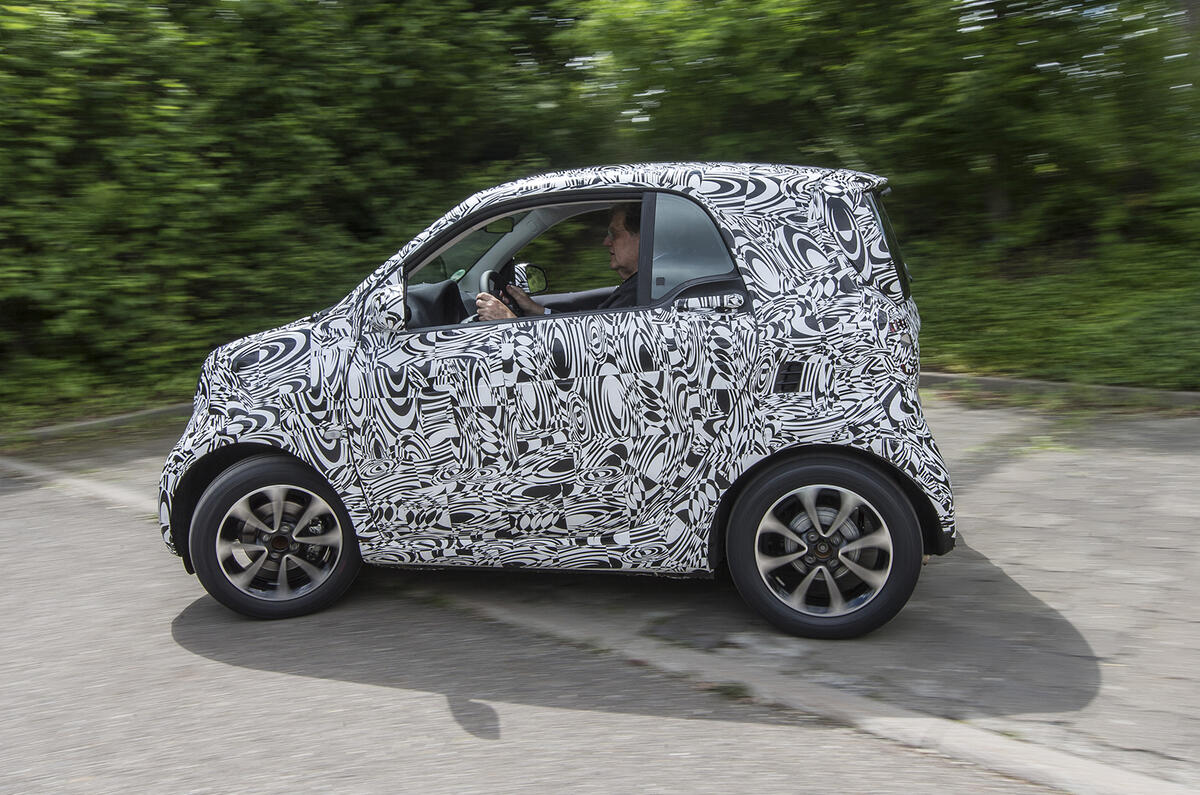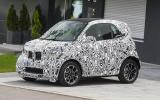After a problem childhood and a spotty adolescence, Smart has grown up.
The Mercedes-backed company is about to unveil an all-new version of its Smart Fortwo microcar that keeps its predecessor’s best-loved characteristics – including the all-important 2.69m overall length – but adds big-car features that even Smart lovers never thought they’d see.
It will be built, as usual, in the Hambach factory in western France. Under a new deal, the third-generation Smart range is being produced in cooperation with Renault, whose own-shape, five-door version – the new Twingo, revealed at Geneva last March – will be built on an all-new platform alongside the returning five-door Smart Forfour in Renault’s Slovenia factory, which produced previous Twingo models. As well as providing the factory, Renault contributes a trio of baby petrol engines to the new-generation Twingo-Smart project.
View our exclusive Smart Fortwo and Forfour gallery
Both short and long Smart models are due to make their official appearance in mid-July, but Autocar has already had exclusive access to a pair of Fortwo prototypes at Smart’s HQ in Boblingen, near Stuttgart. We drove one version on an ultra-tight manoeuvring course inside the factory and were then driven in another on a wide selection of local roads to show off the car’s improved all-roads capability.
Perhaps the biggest news is the demise of Smart’s much-criticised automated manual gearbox, infamous for its slow, ‘nodding dog’ gearchanges. Future Renault and Smart buyers will be offered the choice of a conventional five-speed manual (yes, there’s room for a clutch pedal) or a new, compact Getrag six-speed twin-clutch gearbox. This move alone is especially likely to boost interest in the Fortwo, which has consistently lost ground to other city cars on account of its ‘funny’ gearchange.
Other highlights are a 10cm increase in the Fortwo’s body width, which brings many benefits. Where cabin space is concerned, the Smart two-seater now has far more hip and shoulder room so it no longer needs the staggered seats of past models (although it keeps their high hip-point and big doors for spectacularly easy access) and – although our disguised pictures won’t yet show it – its styling recalls the chic shape of the original car, which gave way to a ‘Tonka toy’ shape in the second version that was less well received.
ForTwos have always used a pressed steel Tridion chassis frame as their main structure, supporting impact-absorbing plastic outer panels, and that layout is used again. So is a rear-engined layout: an ultra-compact three-cylinder engine mounted under the boot floor, in unit with the gearbox and differential and driving the rear wheels.
The entry-level engine for UK buyers will be a brand-new 999cc Renault-made triple, designated SCe70. It is normally aspirated, is rated at 70bhp and develops its 67lb ft peak torque virtually from ground level, ideal for town motoring. It will come with stop-start as an option. The top spec offering is Renault’s zippy Energy TCe90 899cc turbo triple that punches out 89bhp and 100lb ft, has standard stop-start and Euro 6 clean air compliance. This engine has already been used in the Captur and Clio but the engine has been adapted specifically for Twingo-Smart to provide what Renault calls “refined performance”.
The related models keep their all-independent wishbone suspension, but the extra body width now allows longer suspension arms with wider-based mountings to be used, for better wheel control. There’s more suspension travel, too, which improves the ride considerably because less of the suspension stroke is affected by contact with the bump-stops…
Inside the Boblingen HQ, I first meet Frank Zimmerman, Smart's head of product marketing, who shows me the two prototypes, summarises (without too much detail) the changes – and assures me that one key objective in the development of the Fortwo has been to maintain what he terms “the 269”, the car’s diminutive length of 2.69m.
“We did lots of research among existing owners,” says Zimmerman, “which showed their number one reason for buying was the car’s shortness. So we fought hard to maintain it. We’ve kept the height the same, too. Owners say the big doors and the high hip-point are also features they like.” However, you certainly can’t miss the extra body width, which makes Zimmerman (tall) and me (wide) perfectly comfortable sitting side by side in the cockpit. It also makes the car look much tougher and more grown-up on the road.
The patch of tarmac that they’ve allotted for my manoeuvring test seems slightly smaller than a postage stamp. It’s difficult to imagine that we’ll be able to do anything meaningful but Zimmerman insists that there will be plenty of space for a car that now has a turning circle between kerbs of just 6.9m, less than 23 feet. It can out-turn a Toyota iQ by a metre, and easily corner inside a London cab’s U-turn.
Read more about the new Smart Fortwo and Forfour
I try it, enjoying the accurate but easy-twirling electric power steering, and discover that it’s possible to throw complete circles in this tiny space without even using full lock. “Turn tighter,” the photographer keeps saying, although in space terms there’s no need. The car manoeuvres easily and shows no sign of tyre scrub, even on full lock. The point is made: adding a few inches to the width of a Smart is nothing compared with carving half a yard off its turning circle. There can’t now be a more agile car on the market.
The gearbox action (and the knob itself) has obvious Renault connections but is none the worse for that. The clutch is light and there’s plenty of left-foot space, at least in this left-handed version. The lever has a sweet, short throw. Suddenly, the Fortwo, even at 5-10mph in a cramped car park, takes a big step forward in sporty character.
Now it’s time to drive with Christophe Schulenberg, Smart's head of testing and a Smart-Swatchmobile ‘lifer’ despite his youthful appearance. We set off with considerable verve on a 40-minute route that at first takes us zipping around a crowded multi-storey car park and then varied public roads.
We do tight turns and gutters, and then cobblestones and suburban ruts. Impressions come thick and fast: first is the ease and control of the new dual-clutch gearbox, which comes with a selectable Sport mode and manual control.
It’s clear very soon that this car is much more stable everywhere than its predecessor, especially when cornering, and the choppy ride is also much improved. The feeling of tautness and strength stays – that was always impressive – but the car is much, much quieter over bumps. (Schulenberg explains how much revisions to the suspension bushes have helped.)
Having been an early Smart owner, I wonder whether the Fortwo’s high-speed stability might still be problematic, especially in crosswinds, but Schulenberg reckons that the wider track, more positive steering and better suspension geometry mean that it’s “no longer an issue” and backs that by revealing that for this new model the governed speed limit that started out at 83mph in my day and progressed to 90ish, will be allowed to go higher again.
Bottom line? We arrive back at base and I realise that in the past 10 minutes of our 40 I haven’t thought much about the car’s dynamics. Our talk has turned to manufacturing details, because the car just feels so normal.
I’ve done lots of miles in Smarts, and never before have I lost the overriding perception of its shortness, signified by the perpetualpitching of a rather crashy suspension. For the first time, a two-seat Smart feels like a normal car. Amazingly compact it remains, but it seems to have caught up with the rest.
Find out more about the Smart Fortwo and Forfour.
Get the latest car news, reviews and galleries from Autocar direct to your inbox every week. Enter your email address below:

























Join the debate
Add your comment
The Smart ForTwo has always been rear drive.
Smart has become...
Looking forward